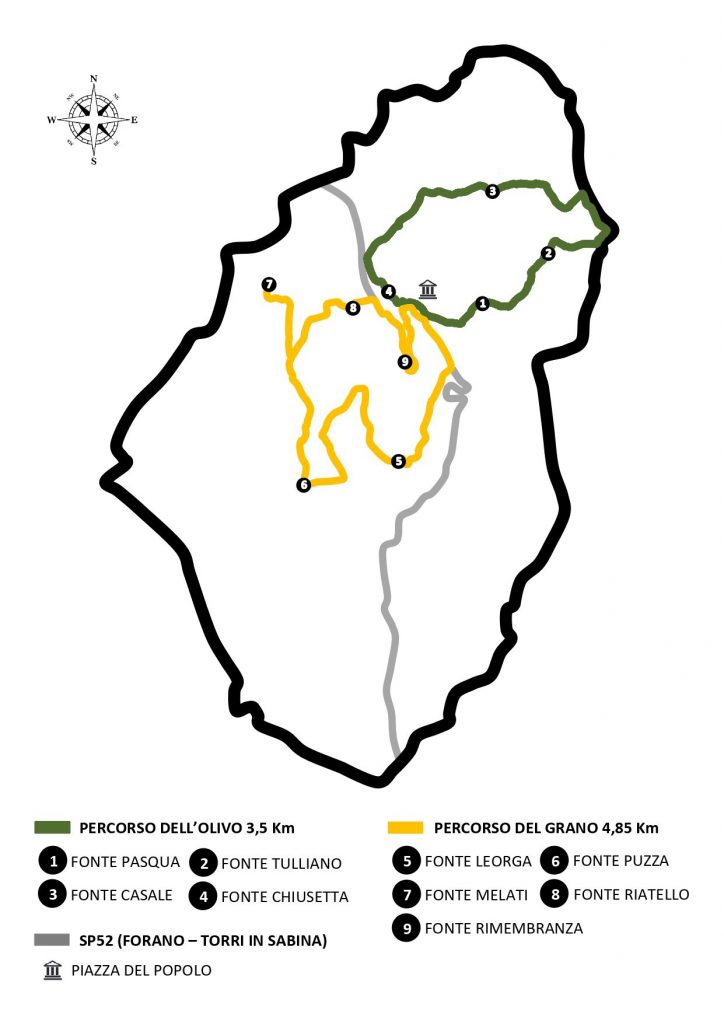UN PAESE CI VUOLE 2020 “Alla riscoperta delle fonti perdute”
Avviso pubblico per la valorizzazione dei piccoli comuni del Lazio
Legge Regionale 15 novembre 2019 n° 24

ALLA RISCOPERTA DELLE FONTI – RECOVERY OF THE FORG
“Un paese ci vuole, non fosse che per il gusto di andarsene via. Un paese vuol dire non essere soli, sapere che nella gente, nelle piante, nella terra c’è qualcosa di tuo, che anche quando non ci sei resta ad aspettarti.”, scriveva così cesare Pavese in uno dei passaggi più belli de “La Luna e i Falò”, romanzo del ritorno all’ambiente rurale e di recupero di quelle che sono le radici di una comunità.
La proposta progettuale dal titolo “Alla riscoperta delle fonti perdute” si pone in quest’ottica, recuperando quel che, da un punto di vista materiale, racconta di generazioni passate e di vecchie tradizioni; luoghi e spazi di primaria importanza nel passato, che continuano a stare lì, testimoni senza età del tempo che scorre.
Il territorio di Selci, si caratterizza per un decentramento rispetto al centro storico; gran parte della cittadinanza tutt’oggi risiede presso le colline che contornano il borgo medievale.
Tale situazione, in tempi remoti, mise gli abitanti nella condizione di doversi approvvigionare di acqua sia per usi domestici, sia per il sostentamento del bestiame, sfruttando le polle d’acqua che spuntavano in alcuni terreni e costruendo questi manufatti visibili ancor oggi.
La linea culturale seguita dall’attuale Amministrazione Comunale, si è sin da subito rivelata attenta a valorizzare e recuperare la memoria storica del paese e tutte le annesse sfaccettature relative alla tradizione rurale.
Alla riscoperta delle fonti perdute è un ulteriore tentativo di proseguire su questa linea, recuperando le fonti e gli spazi in cui queste sorgono, delle vere e proprie aree verdi di caratteristico pregio ambientale, restituendo alla popolazione dei passaggi alternativi immersi nella natura benevola del paese.
Il progetto è stato realizzato con il coinvolgimento attivo dell’associazione La Clessidra APS dall’ ideazione, alla progettazione fino alla destinazione del bene a regime, che ha coordinato la partecipazione sociale con la cittadinanza attiva, le imprese e gli artigiani locali, i volontari e gli artisti, che hanno collaborato alla ricerca di informazioni storiche e alla realizzazione dei lavori.
Le fonti ristrutturate sono state inserite in due percorsi naturalistici, che permetteranno ai visitatori di conoscere ogni aspetto del paesaggio rurale di Selci.
“One needs a village, even if it’s only for the pleasure of leaving it. Your own village means you’re not alone, that you know there’s something of you in the people and the plants and the soil, that even when you are not there it waits to welcome you”. (Source: The moon and the bonfires (1950), Chapter I, p. 9) Cesare Pavese writes this in one of the most beautiful passages of his book “La Luna e i Falò – The Moon and Bonfires”. A story that deals with the return to rural surroundings and the recovery of the roots of people who live in a community.
“Alla riscoperta delle Fonti Perdute” – Recovery of the Forgotton Wellsprings” is the title of the proposed project which puts itself into this frame of mind, disclosing from a materialistic point of view, recollections of past generations and ancient traditions; places and areas of primary importance from the past, which continue to be there as an ageless testimony to the passage of time.
The area of Selci is characterized by a displacement of the population from the main old village center; the majority of the residents still today residing in the hills which surround the old medieval settlement.
In the past, this situation put the inhabitants in the condition of having to collect and store water for both domestic use and for the survival of their animals, taking advantage of the large amounts of water available that flowed from various sites, creating the structures that we are able to see to this day.
Right from the very start of the present day local administration, a distinct cultural line of thought is followed, that of being attentive to the merits and enhancement of retrieving the historical testimony of the village and of its various connections regarding the rural traditions.
“Alla riscoperta delle Fonti Perdute – Recovery of the Forgotton Wellsprings” is a further attempt to continue along this line, with the retrieval of the wellsprings and the spaces in which they reside, true green spaces of intrinsic characteristic value, giving back to the community alternative areas immersed within the pleasant village countryside.
The project has been put together with the active participation of the “Clessidra APS Association”, from the creation to the actual planning, right up until the completion of the final result, coordinating the participation of the active locals, the businesses and local craftsmen, volunteers and artists, who have all helped in the research for historical information and the actuation of the work involved.
The renovated wells are divided into two different naturalistic paths, in order to let the tourists visit all the unknown rural beauties of Selci.

PERCORSO DELL’OLIVO – OLIVE PATH
1 – FONTE PASQUA
La fonte della leggenda
Dell’antico manufatto fatto realizzare nel 1927 dall’allora podestà Annibale Savini, rimane solo una parte del frontone inciso in marmo bianco, custodito nel museo della torre comunale Rocca Castri.
La leggenda narra che il nome sia dovuto al brutale assassinio di una giovane ragazza di nome Pasqua, avvenuto presso questi luoghi, tanto che alcuni anziani del paese riferiscono di cose quasi soprannaturali che succedevano presso la fonte. Il fascino di Fonte Pasqua con le sue leggende e la sua natura spettacolare è ancora motivo di vanto e di emozione per gli abitanti.
Vegetazione presente: orchidee selvatiche, macchia mediterranea
Tipologia fonte: sorgiva
The legend’s spring
Of the ancient artifact commissioned in 1927 by the head of town Annibale Savini, there remains only a part of the pediment engraved in white marble, kept in the Rocca Castri municipal tower museum.
Legend has it that the name is due to the brutal murder of a young girl named Pasqua, which took place here, so much so that some elders of the town report almost supernatural things that happened at the spring. The charm of Fonte Pasqua with its legends and its spectacular nature is still a source of pride and emotion for the inhabitants.
Vegetation present: wild orchids, Mediterranean bush
Type of Spring: natural water spring
2 – FONTE TULLIANO
La fonte dell’alloro
La fonte, nonostante sia stata realizzata solo in epoca moderna, era alimentata con sorgente antica. Deve il suo nome alla gens Tullia, come il colle su cui si erge, che abitava questi territori in epoca romana.
Il manufatto, ha subìto una recente restaurazione non particolarmente invasiva. L’originale sorgente che la alimentava è probabilmente stata deviata con costruzione di pozzi privati ed oggi viene alimentata da una cisterna di raccolta acque.
Vegetazione presente: alloro, edera
Tipologia fonte: condottata
Laurel spring
The fountain, although it was built in modern times, was once fed by an ancient spring.
It owes its name to the gens Tullia, like the hill on which it stands, who inhabited these territories in Roman times. The artifact has undergone a recent restoration not particularly invasive.
The original spring that fed, it was probably diverted with the construction of private wells and today it is fed by a water collection tank.
Vegetation present: laurel, ivy
Type of Spring: Water collection tank.
3 – FONTE CASALE
La fonte della lavanda
Antica sorgente di straordinaria purezza, grazie alla notevole altezza in cui nasce, ha alimentato per anni le condutture che portavano al centro storico e al palazzo baronale, soddisfacendo il fabbisogno di un’intera comunità. Le sue acque scorrevano all’interno dell’omonimo acquedotto, costruito in epoca romana, che presenta oltre 100 metri di gallerie e cuniculi ed è testimonianza tangibile della cultura della Roma antica, presente in Sabina.
Vegetazione presente: arbusti spotanei
Tipologia fonte: sorgiva
Lavender spring
An ancient spring of extraordinary purity, thanks to the considerable height at which it is born, it fed for years the pipes that led to the historic center and the baronial palace, satisfying the needs of an entire community. Its waters flowed inside the aqueduct bearing the same name, built in Roman times, which has more than 100 meters of tunnels and passages and is a tangible testimony of the culture of ancient Rome, in the Sabina area.
Vegetation present: spontaneous shrubs
Type of Spring: natural water spring
4 – FONTE CHIUSETTA
La fontanella
La fonte, che mantiene ancora il manufatto originale, realizzata a sassi e dotata di notevoli abbellimenti architettonici, sorge in una piaggia dimenticata.
Chiamata familiarmente dagli abitanti “La Fontanella”, oggi è stata rinominata Chiusetta, dal nome della località in cui si trova. Il fango e la melma che l’hanno investita durante l’alluvione del 1979 hanno rialzato il livello del suolo e ricoperto le quattro grandi lastre di pietra, originariamente posizionate all’ingresso.
Vegetazione presente: edera, sambuco, agrifoglio
Tipologia fonte: sorgiva
The small fountain
The fountain, which still maintains the original artifact, made of stones and with remarkable architectural embellishments, stands on a forgotten slope.
Familiarly known by the inhabitants as “La Fontanella”(the small fountain), today it has been renamed Chiusetta, like the locality in which it is situated. The mud and slime that hit it during the 1979 flood raised the ground level and covered the four large stone slabs, originally positioned at the entrance.
Vegetation present: ivy, elderberry, holly.
Type of Spring: natural water spring
PERCORSO DEL GRANO – WHEAT PATH
5 – FONTE LEORGA
La fonte sacra
Una delle fonti più antiche, risalente approssimativamente al Basso Medioevo, era venerata dagli abitanti come fonte sacra, vista l’importanza che rivestiva per il sostentamento della comunità.
La versione attuale, che presenta due grandi vasconi, è frutto di varie ristrutturazioni: all’originario unico fontanile, sono state aggiunte 2 vasche per soddisfare le esigenze del bestiame e delle lavandaie delle campagne.
Recentemente, sotto il terreno circostante, si è scoperta la presenza di una conduttura a mattoni, che si ritiene essere la più antica versione.
Vegetazione presente: quercia, felce
Tipologia fonte: sorgiva
The sacred spring
One of the oldest fountains, dating back approximately to the Late Middle Ages, was venerated by the inhabitants as a sacred spring, given the importance it had for the sustenance of the community.
The current version, which has two large basins, is the result of various renovations: these basins in fact have been added to the original single basin fountain, to meet the needs of the livestock and the washerwomen of the countryside.
Recently, under the surrounding land, it has been discovered the presence of a brick pipeline, that is believed to be an earlier version of the structure.
Vegetation present: oak, fern
Type of Spring: natural water spring
6 – FONTE PUZZA
La fonte dell’acqua odorosa
Nei decenni scorsi era adibita al fabbisogno degli animali, tanto che le mucche venivano portate a dissetarsi con la “barrozza” girandole intorno, cosa non più possibile in seguito alla privatizzazione dei terreni circostanti. Non è chiaro l’origine del nome ma sembra dovuto al fatto che l’acqua risultasse “pesante”, forse di origine lievemente sulfurea.
L’iperico che vi nasce spontaneo, chiamato comunemente erba di San Giovanni, si utilizza per preparare la tradizionale acqua propiziatoria.
Vegetazione presente: iperico, edera, equiseto
Tipologia fonte: sorgiva
Smelly water spring
In recent decades it was used for the needs of animals, so much so that the cows were brought to quench their thirst whilst carrying the wagon and going around it, which is no longer possible following the privatization of the surrounding land. The origin of the name is not clear, but perhaps it is due to the fact that the water was perceived as “hard” to digest, perhaps even of slightly sulphureous origin.
The hypericum that grows spontaneously there, commonly called St. John’s wort, is used to prepare a traditional propitiatory water.
Vegetation present: hypericum, ivy, horsetail
Type of Spring: natural water spring
7 – FONTE MELATI
La fonte del grano
Costruita per il fabbisogno personale della famiglia Melati, un tempo proprietaria di gran parte dei territori della “collina del grano” su cui si erge, è stata in seguito messa a disposizione di coloni e mezzadri. Ad oggi viene utilizzata esclusivamente dagli allevatori dei terreni limitrofi.
La ristrutturazione subita decine di anni fa, per contenere la pressione del terreno sul frontone in pietra e sassi, ha modificato notevolmente l’aspetto estetico originale, che è stato attualmente recuperato in parte.
Vegetazione presente: noci, tigli, sottobosco
Tipologia fonte: sorgiva
Wheat Spring
Built for the personal needs of the Melati family, once owner of most of the land of the “grain hill” on which it stands, it was later made available to farmers and sharecroppers. Nowadays it is used exclusively by breeders from neighbouring lands.
The restructuring done decades ago, to contain the pressure of the ground on the stonewalls, has significantly changed the original aesthetic appearance, which has now been partially recovered.
Vegetation present: walnuts, lime trees, undergrowth
Type of Spring: natural water spring
8 – FONTE RIATELLO
La fonte delle api
Il manufatto originale composto di due vasche non esiste più, poiché la fonte è stata interamente sommersa da fango e detriti durante l’alluvione del 1979.
Per la successiva ricostruzione si è scelto di realizzare un unico vascone rialzato, tuttora presente.
Originariamente utilizzata per il fabbisogno del bestiame e per alimentare i lavori dell’importante fornace di laterizi che si trovava a pochi metri di distanza, ancora oggi è molto utilizzata da allevatori e aziende agricole limitrofe.
Vegetazione presente: salice di fiume, equiseto, felce
Tipologia fonte: sorgiva
The bees spring
The original structure consisting of two basins no longer exists, since the source was entirely covered by mud and debris during the 1979 flood.
For the following reconstruction, it was decided to build a single raised basin, which still exists today.
Originally used for the needs of livestock and to support the important brick kiln that was located a few meters away, it is still widely used today, by neighboring breeders and farms, for the large amount of water it provides.
Vegetation present: river willow, horsetail, fern
Type of Spring: natural water spring
9 – FONTE RIMEMBRANZA
La fonte dei caduti
La fonte che sorge proprio accanto al parco dedicato ai caduti, venne fatta costruire nel XX secolo per volontà del Podestà Mario Savini Nicci.
Si trattava di un fontanile costituito da vasca e lavatoio, alimentato da una piccola sorgente. Tale fonte, dall’aspetto rudimentale e parsimonioso, serviva semplicemente la popolazione in via sussidiaria, non ricoprendo un ruolo fondamentale, vista anche la non potabilità delle acque.
Vegetazione presente: cipressi limitrofi del Parco dei Caduti
Tipologia fonte: sorgiva
War memorial spring
The fountain, which stands right next to the park dedicated to the soldiers fallen in battle, was built in the twentieth century by the will of the then mayor Mario Savini Nicci.
The structure consists of a basin and washhouse, fed by a small spring.
This fountain, with its rudimentary and thrifty aspect, simply served the population as a subsidiary, not playing a fundamental role, also given the fact that the water is non-potable.
Vegetation present: cypresses of the War memorial.
Type of Spring: natural water spring
Ideazione e progettazione: Comune di Selci – La Clessidra APS
Coordinamento: La Clessidra APS
Promozione: La Clessidra APS
Testi: Maddalena Antonini – Serena Caponi
Traduzioni: Miranda Goodman – Daniele Piserchia – Raissa Stefanini
Foto e Video: Alessandro Antonini
Pagina web: Samuele Celommi – Stefano Celommi
(Tutti i diritti riservati.)
Idea and planning: Comune di Selci – La Clessidra APS
Coordination: La Clessidra APS Promotion: La Clessidra APS
Texts: Maddalena Antonini – Serena Caponi
Translation: Miranda Goodman – Daniele Piserchia – Raissa Stefanini
Photos and videos: Alessandro Antonini
Web page: Samuele Celommi – Stefano Celommi
(All rights reserved.)
 La Clessidra APS
La Clessidra APS